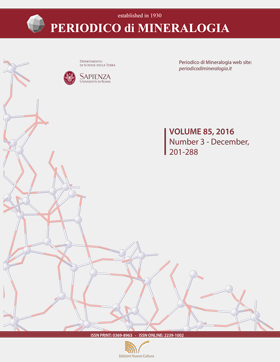The crystal structure of mineral fibres: 1. Chrysotile
DOI:
https://doi.org/10.2451/2016PM655Keywords:
Mineral fibres, chrysotile, Rietveld, iron.Abstract
This work reports the results of the structural study of three representative chrysotile samples of different provenance (Canadian UICC, and Italian Balangero and Valmalenco). Chemical composition was determined using EMPA and TG data. An innovative wet cryo-milling procedure was used to powder the resistant-to-abrasion chrysotile fibres. X-ray powder diffraction patterns were collected using both conventional and non-conventional sources. Collected data were used for Rietveld structural refinements and results were compared with available literature data. The three samples display similar structure models, although small differences were detected in the position of the oxygen atoms. Both the structural refinements and spectroscopic investigations confirms that Fe2+ and Fe3+ atoms in chrysotile are located in the octahedral cavities only, substituting for Mg2+. Regarding the atom coordinates, UICC chrysotile is the more similar to the model reported by Falini et al. (2004). About the lattice parameters, the Valmalenco chrysotile is the more similar, if compared with the Balangero and UICC, to both the model proposed by Whittaker (1956a,b) and Falini et al. (2004). This work is intended as a basis for subsequent studies aimed at understanding the potential toxicity of these mineral fibres.


